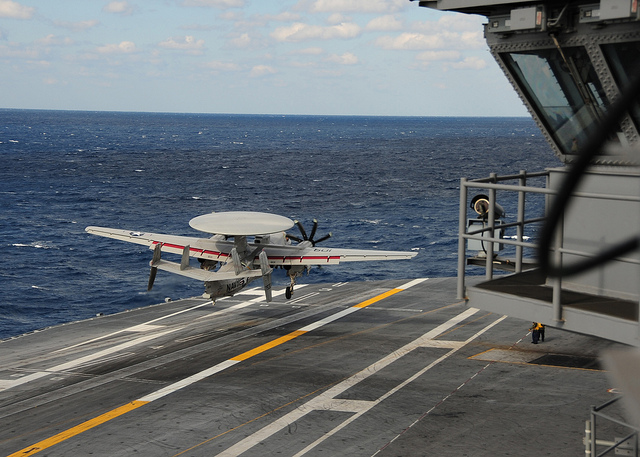|
|
| a |
Focus - Northrop Grumman E-2D Advanced Hawkeye |
| |
|
| |
| |
E-2D Advanced Hawkeye: The Sixth Sense of the XXIst Century U.S. Navy
Fleet |
| |
By Xavier Vavasseur
Navy Recognition recently visited the Northrop Grumman facility
in Melbourne, Florida. This was the occasion to meet with Jay Mulhall,
Director of Business Development for the E-2/C-2 programs and with Fred
Shelton, manager of international business development for the E-2C/D
programs. So here is what we learned about the next generation airborne
early warning and control (AEW&C) of the U.S. Navy: The E-2D Advanced
Hawkeye. |
|

Since the first E-2D Advanced Hawkeye took to the skies over
St. Augustine, Fla., for the first time in August 2007, Northrop Grumman
has delivered 14 new production E-2Ds to the U.S. Navy, on cost and
on schedule. An additional 10 aircraft are in various stages of manufacturing
and predelivery flight testing at the company's St. Augustine Aircraft
Integration Center. Initial operational capability with the Navy remains
on track for FY2015. Picture: US Navy
|
|
The E-2D Advanced Hawkeye is the newest variant of
the E-2 aircraft platform. It features a new radar and upgraded aircraft
systems. The U.S. Navy is set to receive 75 Advanced Hawkeyes with an
IOC expected in October 2014 and first aircraft carrier deployment in
2015. Naval Air Systems Command (NAVAIR) awarded a $3.643 billion multi-year
procurement contract to Northrop Grumman on June 30 for 25 E-2D Advanced
Hawkeye aircraft.
The E-2D Advanced Hawkeye provides 360-degree automatic, simultaneous
air and sea surface radar detection with multimode long-range identification
friend or foe (IFF) detection, automatic radar correlation, and long-range
passive detection and classification of electronic emitters. It distributes
the tactical picture to command centers and other assets through its
onboard communication subsystems. The U.S. Navy also uses this capability
to participate in humanitarian and disaster-relief operations.
|
|
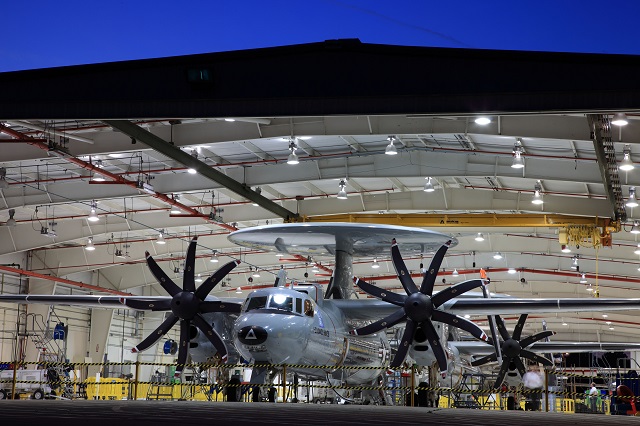
An E-2D Advanced Hawkeye rolling out of the final assembly line
in St. Augustine Florida. It takes about two years to built an aircraft.
Northrop Grumman is working with a network of about 230 suppliers. Picture:
Northrop Grumman
|
|
E-2D Advanced Hawkeye: A new aircraft
The E-2D may look like a C model but actually features so many
differences that we cannot list them all in detail in this article.
All the electronics, from the radar to the aircraft systems and avionics
have been upgraded. The cockpit features 3 large (17 inch) display that
the pilot and co-pilot can use not only to fly the aircraft but also
to receive the same information as in the combat information center
(CIC) in the back. Advanced Hawkeye pilots and co-pilots are not "just"
flying the aircraft: They may become a 4th operator if the need arises.
We were told that the U.S. Navy adapted the training of its Hawkeye
pilots in consequence.
Speaking of the CIC, it features three workstations (with 20 inch display,
featuring open architecture and computing environment) for one ACO (Air
Control Officer), a CICO (Combat Information Center Officer) and a RO
(Radar Officer).
Compared to legacy "C" model Hawkeyes, the "D" model
features a new environmental control system (with better cooling capacity),
a new digital ESM, a new electrical system (with vast margin for future
growth), new mission data processing (based on COTS components, high-speed
processors and a fiber-optic LAN), upgraded communications...
The whole structure of the aircraft has been beefed up allowing for
higher aircraft carrier landing weight and future growth.
The U.S. Navy is transitioning 1 squadron a year to the E-2D with each
squadron replacing 4 Hawkeyes with 5 Advanced Hawkeyes. Each squadron
will retain the same number of maintainers however, which illustrates
its ease of maintenance.
|
|
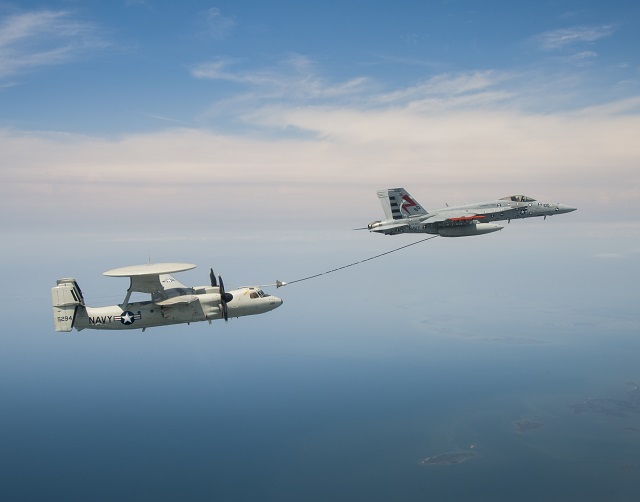
An E-2C performs an aerial refueling flight test with an F/A-18
at NAS Patuxent River. PMA-231 plans to equip the E-2D with this capability
to extend its mission endurance. U.S. Navy photo by Liz Wolter
|
|
Maximized endurance thanks to future in-flight
refueling capability
In January this year, the U.S. Navy awarded Northrop Grumman
a contract for engineering, manufacturing and demonstration of an in-flight
refueling (IFR) system for the E-2D Advanced Hawkeye aircraft. The greater
endurance provided by in-flight refueling will provide the U.S. Navy
with increased surveillance and targeting capability and the persistence
needed to accomplish this more effectively. It will also allow the aircraft
to loiter for longer period of time, further out. The planned IOC for
the IFR capability is 2019.
To increase crew effectiveness during the longer missions (up to 8 hours
thanks to IFR), Northrop Grumman offers "optional air vehicle enhancements"
consisting in:
» Food and beverage galley
» Crew
lavatory
» Ergonomic
seats
» Noise
canceling aviation headsets
» Air
conditioning
|
|
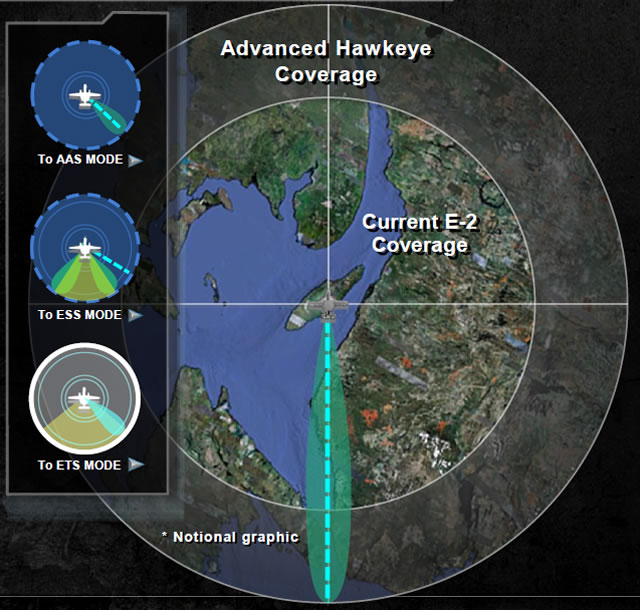
Infographic showing the notional difference in range between
the E-2C and E-2D
|
|
AN/APY-9: A next generation radar which
excels at detecting cruise missiles
According to Northrop Grumman, current mechanically scanned
and pure electronically scanned radars have inherent shortcomings that
limit their effectiveness and compromise their capabilities. The Advanced
Hawkeye’s completely new APY-9 radar merges a traditional mechanically
scanned antenna with steerable electronic scanning: Operators get the
best of both world (or more accurately, the best of both technologies).
Mechanically rotated electronic scan radar provides uniform 360 detection
coverage, independent of ownship aircraft orientation to the target.
No compromises as seen when integrated fixed radars on commercial aircraft.
The improvements of the APY-9 compared to the E-2C radar (AN-APS-145)
are many:
»
Increased range
»
Enhanced detectability of air targets both over sea and
land
»
Surface target tracking out of horizon
»
Reduction of clutter in coastal area and
over land
»
Precision tracking of maneuvering
targets against ground clutter
»
Long range detection of cruise
missiles
Northrop Grumman
representatives stressed this last point to us: A great deal of energy
was focused on detecting cruise missiles, both over sea and land. This
was a requirement of the U.S. Navy
|
|
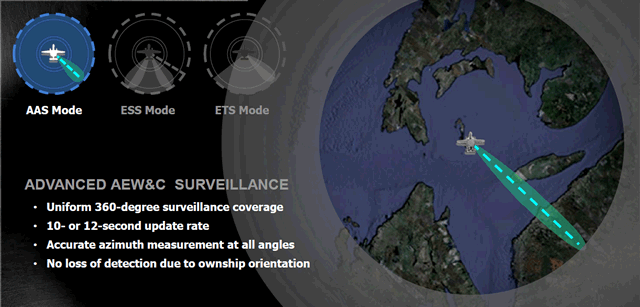
Infographic showing the three radar modes of the revolutionary
APY-9 radar
|
|
AN/APY-9: Different modes for different
types of targets
The new Advanced Hawkeye radar offers three modes to the operators,
depending on the situation.
AAS Mode: Advanced AEW Surveillance. The Advanced Hawkeye’s
state-of-the-art ultra high frequency radar provides uniform 360-degree,
simultaneous air and surface coverage with longrange detection of low
radar cross-section targets.
ESS Mode: Enhanced Sector Scan. Merges a traditional mechanically
scanned antenna with steerable electronic scanning technology to bring
the benefits of both technologies, while eliminating the shortcomings
of either technology on its own.
ETS Mode: Enhanced Tracking Sector. Pure electronic scanning,
geographically stabilized or following a target, provides enhanced detection
and tracking in a selected sector. No lost tracks in turns.
|
|
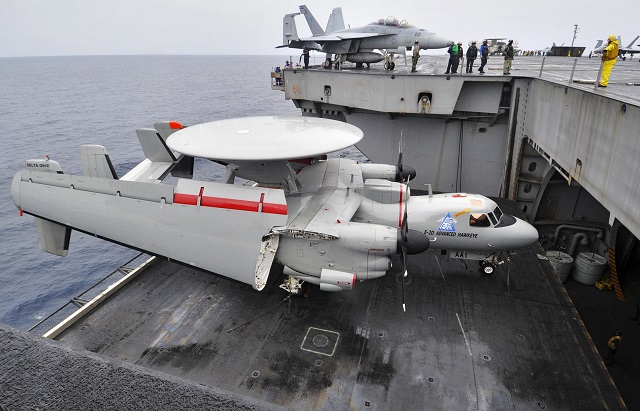
An E-2D Hawkeye assigned to Test and Evaluation Squadron is
moved from the flight deck to the hangar bay aboard the aircraft carrier
USS Harry S. Truman. The "D" model is aboard Harry S. Truman
for operational testing and evaluation before delivery to the fleet.
Picture: U.S. Navy |
|
E-2D
Advanced Hawkeye: Truly multi-mission
The E-2D advanced detection and information processing capabilities
enable multi-mission situation awareness. The Advanced Hawkeye’s
radar and identification friend or foe system can detect targets at
ranges in excess of 300 nmi. Its electronic support measure system detects
and classifies targets at distances beyond radar limits. The onboard
communications and data processing subsystems are capable of collecting
and distributing the tactical picture to command centers and other assets
for network-centric operations.
Core missions include:
Airborne Early Warning and Maritime missions (AEW, Battle Management
Command and Control, Strike & Intercept Control, Detection &
Tracking of Surface Targets).
Secondary mission: Theater Air Missile Defense
With improved detection and tracking capability, the Advanced Hawkeye
can fulfill an ever-expanding role in littoral and overland operations.
Utilizing its open architecture network connectivity, it will be a key
network enabler and provide the ability to coordinate time-critical
targeting and strike operations.
Civil missions:
The same capabilities that allow the Hawkeye to support military operations
allow it to assist civil authorities with surveillance, command, communications
and control when they are needed. (ATC, SAR, counter piracy, counternarcotics
operations...)
|
